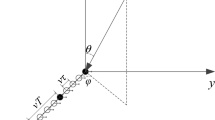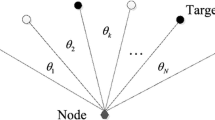Abstract
This paper focuses on the problem of the DOA estimation of coherent signals for the acoustic vector-sensor arrays (AVSAs) in the presence of the isotropic ambient noise. We propose a high-resolution DOA estimation method based on the acoustic intensity principle and the sparse representation technique. First, two cross-covariance matrices are constructed by employing the acoustic pressure and particle velocity components of the AVSA, which eliminates the isotropic noise. Then, in order to fully explore the DOA information of the particle velocity components, an augmented matrix is formed based on the two cross-covariance matrices. We observe an interesting fact that the left singular vector corresponding to the maximum singular value of the augmented cross-covariance matrix is the linear combination of all the signal steering vectors. Based on this fact, a high-resolution DOA estimation algorithm is developed via sparsely representing the left singular vector. This method does not require the prior knowledge of the noise variance or the number of signals to construct the sparse representation model. Simulation and experimental results demonstrate the proposed method outperforms the MUSIC method based on the forward/backward spatial smoothing and some existing sparse representation methods in estimation accuracy and angular resolution, especially in the cases of a low signal-to-noise ratio and/or coherent signals with small angular separations.








Similar content being viewed by others
References
X. Bai, Y. Jiang, C. Zhao, Detection of number of sources and direction of arrival estimation based on the combined information processing of pressure and particle velocity using acoustic vector sensor array. Acta Acust. 33(1), 56–61 (2008)
X. Bai, D. Yang, C. Zhao, Coherent signal-subspace method based on combined information processing of pressure and particle velocity using the acoustic vector sensor array. Acta Acust. 31(5), 410–417 (2006)
H. Chen, J. Zhao, Wideband MVDR beamforming for acoustic vector sensor linear array. IEE Proc. Radar Sonar Navig. 151(3), 158–162 (2004)
H. Chen, J. Zhao, Coherent signal-subspace processing of acoustic vector sensor array for DOA estimation of wideband sources. Signal Process. 85(4), 837–847 (2005)
J. Dai, X. Xu, D. Zhao, Direction-of-arrival estimation via real-valued sparse representation. IEEE Antennas Wirel. Propag. Lett. 12, 376–379 (2013)
M. Hawkes, A. Nehorai, Acoustic vector-sensor correlations in ambient noise. IEEE J. Ocean. Eng. 26(3), 337–347 (2001)
M. Hawkes, A. Nehorai, Acoustic vector-sensor beamforming and Capon direction estimation. IEEE Trans. Signal Process. 46(9), 2291–2304 (1998)
M. Hawkes, A. Nehorai, P. Stoica, Performance breakdown of subspace-based methods: prediction and cure, in Processding of IEEE International Conference on Acoustics, Speech, and Signal Processing, Satl Late City, UT, USA (2001), pp. 4005–4008
M. Hawkes, A. Nehorai, Wideband source localization using a distributed acoustic vector-sensor array. IEEE Trans. Signal Process. 51(6), 1479–1491 (2003)
Z.-Q. He, Z.-P. Shi, L. Huang, Covariance sparsity-aware DOA estimation for nonuniform noise. Digit. Signal Process. 28, 75–81 (2014)
N. Hu, Z. Ye, X. Xu, M. Bao, DOA estimation for sparse array via sparse signal reconstruction. IEEE Trans. Aerosp. Electron. Syst. 49(2), 760–773 (2013)
N. Hu, Z. Ye, D. Xu, S. Cao, A sparse recovery algorithm for DOA estimation using weighted subspace fitting. Signal Process. 92(10), 2566–2570 (2012)
M.M. Hyder, K. Mahata, Direction-of-arrival estimation using a mixed \(\ell _{2,0}\) norm approximation. IEEE Trans. Signal Process. 58(9), 4646–4655 (2010)
X. Jing, X. Liu, H. Liu, A sparse recovery method for DOA estimation based on the sample covariance vectors. Circuits Syst. Signal Process. 36(3), 1066–1084 (2017)
J. Li, D. Jiang, X. Zhang, Sparse representation based two-dimensional direction of arrival estimation using co-prime array. Multidimens. Syst. Signal Process. 29(1), 35–47 (2018)
B. Li, B. Xu, Y. Yuan, Preestimation-based array interpolation approach to coherent source localization using multiple sparse subarrays. IEEE Signal Process. Lett. 16, 81–84 (2009)
M.S. Lobo, L. Vandenberghe, S. Boyd, H. Lebret, Applications of second-order cone programming. Linear Algebra Appl. 284(13), 193–228 (1998)
Z. Liu, Z. Huang, Y. Zhou, Array signal processing via sparsity-inducing representation of the array covariance matrix. IEEE Trans. Aerosp. Electron. Syst. 49(3), 1710–1724 (2013)
Z. Liu, X. Ruan, J. He, Efficient 2-D DOA estimation for coherent sources with a sparse acoustic vector-sensor array. Multidimens. Syst. Signal Process. 24(1), 105–120 (2013)
S. Liu, L. Yang, Y. Xie et al., 2D DOA estimation for coherent signals with acoustic vector-sensor array. Wirel. Pers. Commun. 95(2), 1285–1297 (2017)
D. Malioutov, M. Cetin, A.S. Willsky, A sparse signal reconstruction perspective for source localization with sensor arrays. IEEE Trans. Signal Process. 53(8), 3010–3022 (2005)
K.G. Nagananda, G.V. Anand, Subspace intersection method of high-resolution bearing estimation in shallow ocean using acoustic vector sensors. Signal Process. 90(1), 105–118 (2010)
A. Nehorai, E. Paldi, Acoustic vector-sensor array processing. IEEE Trans. Signal Process. 42(9), 2481–2491 (1994)
P. Palanisamy, N. Kalyanasundaram, P.M. Swetha, Two-dimensional DOA estimation of coherent signals using acoustic vector sensor array. Signal Process. 92(1), 19–28 (2012)
S.U. Pillai, B.H. Kwon, Forward/backward spatial smoothing techniques for coherent signal identification. IEEE Trans. Acoust. Speech Signal Process. 37(1), 8–15 (1989)
T.-J. Shan, M. Wax, T. Kailath, On spatial smoothing for direction-of-arrival estimation of coherent signals. IEEE Trans. Acoust. Speech Signal Process. 33(4), 806–811 (1985)
S.-G. Shi, Y. Li, Z.-R. Zhu, J. Shi, Real-valued robust DOA estimation method for uniform circular acoustic vector sensor arrays based on worst-case performance optimization. Appl. Acoust. 148, 495–502 (2019)
P. Stoica, P. Babu, J. Li, SPICE: a sparse covariance-based estimation method for array processing. IEEE Trans. Signal Process. 59(2), 629–638 (2011)
P. Tichavský, K.T. Wong, M.D. Zoltowski, Near-field/far-field azimuth and elevation angle estimation using a single vector hydrophone. IEEE Trans. Signal Process. 49(11), 2498–2510 (2001)
K.T. Wong, Acoustic vector-sensor FFH “Blind” beamforming & geolocation. IEEE Trans. Aerosp. Electron. Syst. 46(1), 444–449 (2010)
M. Wax, J. Sheinvald, Direction finding of coherent signals via spatial smoothing for uniform circular arrays. IEEE Trans. Antennas Propag. 42(5), 613–620 (1994)
J. Wen, B. Liao, C. Guo, Spatial smoothing based methods for direction-of-arrival estimation of coherent signals in nonuniform noise. Digit. Signal Process. 67, 116–122 (2017)
K.T. Wong, M.D. Zoltowski, Self-initiating MUSIC-based direction finding in underwater acoustic particle velocity-field beamspace. IEEE J. Ocean. Eng. 25(2), 262–273 (2000)
K.T. Wong, M.D. Zoltowski, Extended-aperture underwater acoustic multisource azimuth/elevation direction-finding using uniformly but sparsely spaced vector hydrophones. IEEE J. Ocean. Eng. 22(4), 659–672 (1997)
K.T. Wong, M.D. Zoltowski, Root-MUSIC-based azimuth-elevation angle-of-arrival estimation with uniformly spaced but arbitrarily oriented velocity hydrophones. IEEE Trans. Signal Process. 47(12), 3250–3260 (1999)
Y. Wu, G. Li, Z. Hu et al., Unambiguous directions of arrival estimation of coherent sources using acoustic vector sensor linear arrays. IET Radar Sonar Navig. 9(3), 318–323 (2015)
S. Yan, Optimal design of modal beamformers for circular arrays. J. Acoust. Soc. Am. 138(4), 2140–2151 (2015)
Y. Yang, Y. Zhang, L. Yang, Wideband sparse spatial spectrum estimation using matrix filter with nulling in a strong interference environment. J. Acoust. Soc. Am. 143(6), 3891–3898 (2018)
Z. Ye, X. Xu, DOA estimation by exploiting the symmetric configuration of uniform linear array. IEEE Trans. Antennas Propag. 55(12), 3716–3720 (2007)
J. Yin, T. Chen, Direction-of-arrival estimation using a sparse representation of array covariance vectors. IEEE Trans. Signal Process. 59(9), 4489–4493 (2011)
Y. Zhao, L. Zhang, Y. Gu, Y. Guo, J. Zhang, Efficient sparse representation method for wideband DOA estimation using focusing operation. IET Rader Sonar Navig. 11(11), 1673–1678 (2017)
Y.-X. Zou, B. Li, C.H. Ritz, Multi-source DOA estimation using an acoustic vector sensor array under a spatial sparse representation framework. Circuits Syst. Signal Process. 35(3), 993–1020 (2016)
Acknowledgements
This work was supported by the National Natural Science Foundation of China (Grant Nos. 11674074 and 11674075, 61701133).
Author information
Authors and Affiliations
Corresponding author
Additional information
Publisher's Note
Springer Nature remains neutral with regard to jurisdictional claims in published maps and institutional affiliations.
Rights and permissions
About this article
Cite this article
Shi, S., Li, Y., Yang, D. et al. DOA Estimation of Coherent Signals Based on the Sparse Representation for Acoustic Vector-Sensor Arrays. Circuits Syst Signal Process 39, 3553–3573 (2020). https://doi.org/10.1007/s00034-019-01323-7
Received:
Revised:
Accepted:
Published:
Issue Date:
DOI: https://doi.org/10.1007/s00034-019-01323-7




